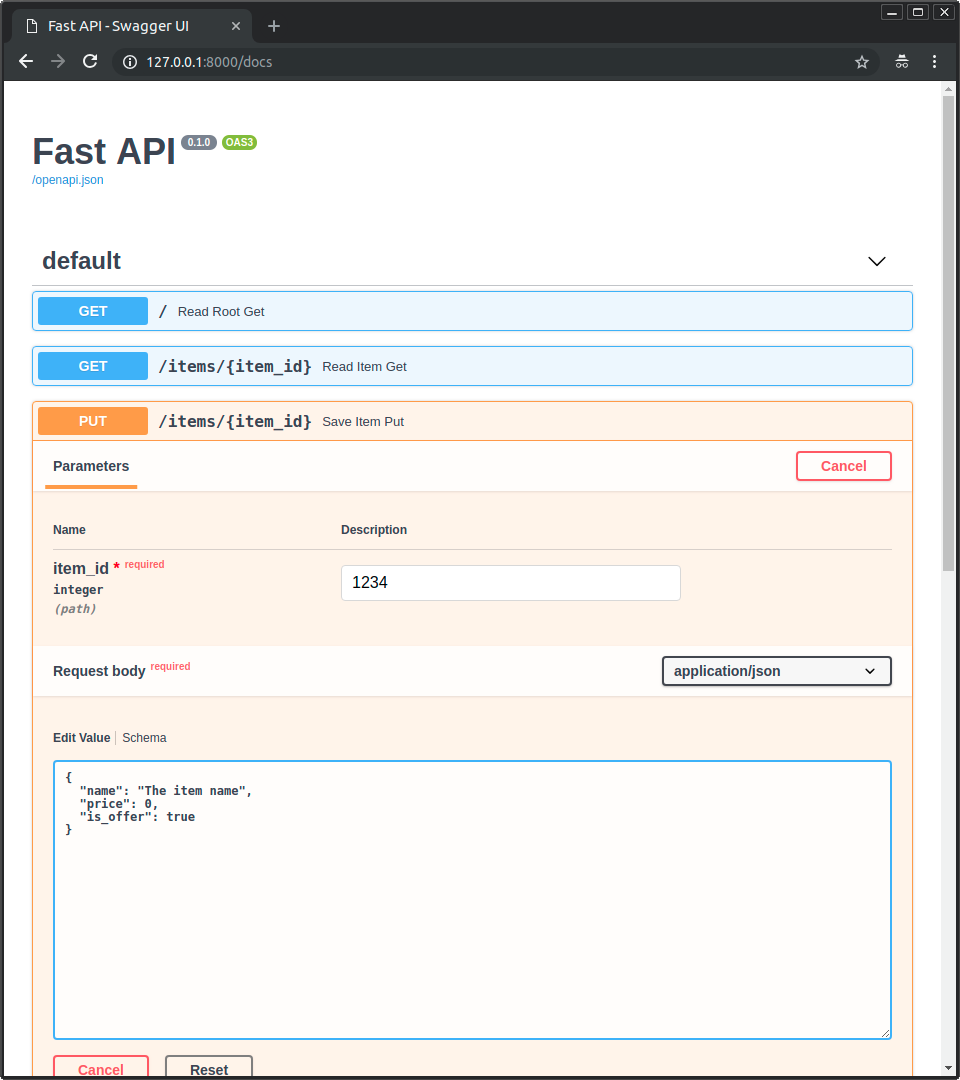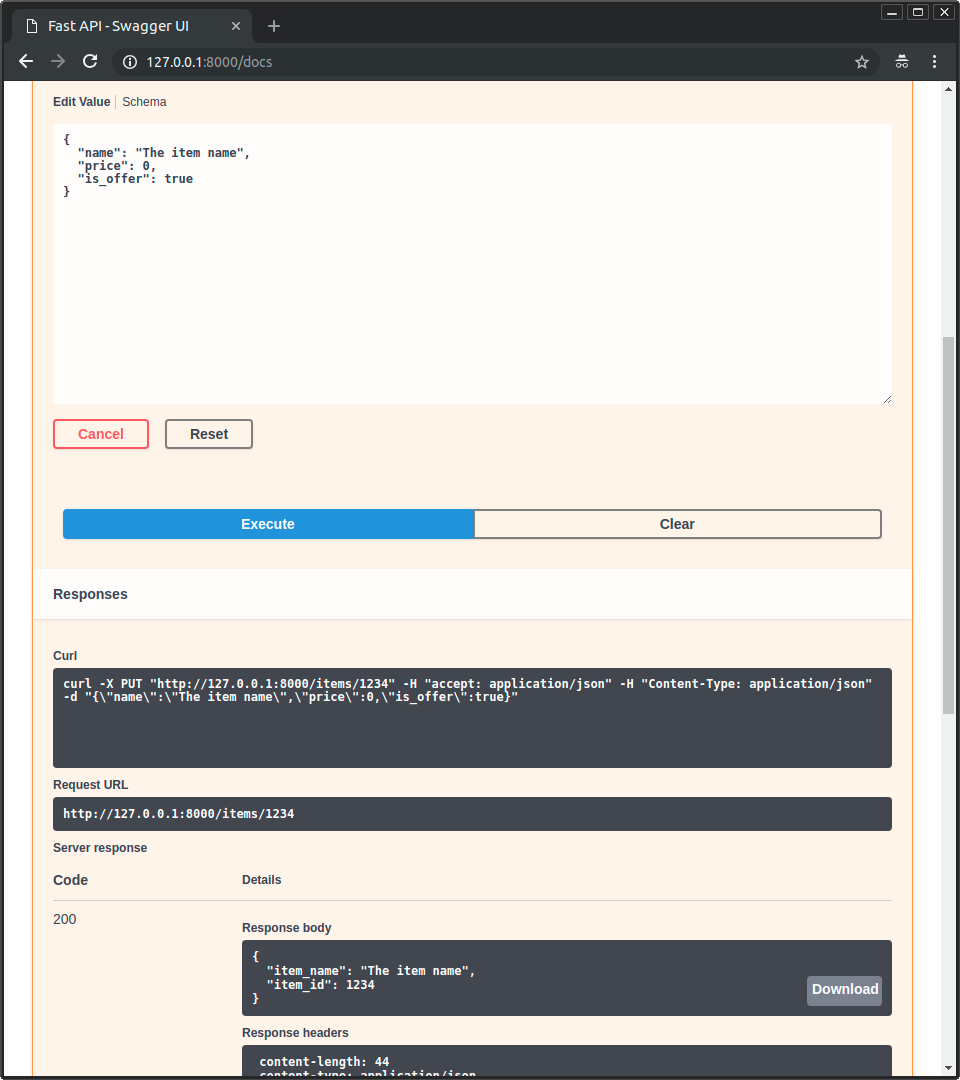- Sort Score
- Result 10 results
- Languages All
Results 41 - 50 of 199 for interactive (0.53 sec)
-
docs/ru/docs/index.md
 * Затем нажмите кнопку «Execute», интерфейс свяжется с вашим API, отправит параметры, получит результаты и отобразит их на экране: 
Registered: Sun Dec 28 07:19:09 UTC 2025 - Last Modified: Thu Dec 11 21:25:03 UTC 2025 - 32K bytes - Viewed (0) -
docs/pt/docs/index.md
* A _rota_ `/items/{item_id}` tem um _parâmetro query_ `q` `str` opcional. ### Documentação Interativa da API { #interactive-api-docs } Agora vá para <a href="http://127.0.0.1:8000/docs" class="external-link" target="_blank">http://127.0.0.1:8000/docs</a>. Você verá a documentação automática interativa da API (fornecida por <a href="https://github.com/swagger-api/swagger-ui" class="external-link" target="_blank">Swagger UI</a>):Registered: Sun Dec 28 07:19:09 UTC 2025 - Last Modified: Tue Dec 16 20:32:40 UTC 2025 - 24.5K bytes - Viewed (0) -
mockwebserver/README.md
.addHeader("Cache-Control", "no-cache") .body("{}") .build() ``` MockResponse can be used to simulate a slow network. This is useful for testing timeouts and interactive testing. ### Java ```java MockResponse response = new MockResponse.Builder() .throttleBody(1024, 1, TimeUnit.SECONDS) .build(); ``` ### Kotlin ```kotlin
Registered: Fri Dec 26 11:42:13 UTC 2025 - Last Modified: Thu Oct 30 21:39:59 UTC 2025 - 8.1K bytes - Viewed (0) -
docs/en/docs/tutorial/query-params-str-validations.md
} ``` /// tip To declare a query parameter with a type of `list`, like in the example above, you need to explicitly use `Query`, otherwise it would be interpreted as a request body. /// The interactive API docs will update accordingly, to allow multiple values: <img src="/img/tutorial/query-params-str-validations/image02.png">
Registered: Sun Dec 28 07:19:09 UTC 2025 - Last Modified: Sat Dec 20 15:55:38 UTC 2025 - 16.7K bytes - Viewed (0) -
docs/en/docs/tutorial/response-model.md
When you see the automatic docs, you can check that the input model and output model will both have their own JSON Schema: <img src="/img/tutorial/response-model/image01.png"> And both models will be used for the interactive API documentation: <img src="/img/tutorial/response-model/image02.png"> ## Other Return Type Annotations { #other-return-type-annotations }
Registered: Sun Dec 28 07:19:09 UTC 2025 - Last Modified: Sat Dec 20 15:55:38 UTC 2025 - 15.5K bytes - Viewed (0) -
docs/fr/docs/tutorial/query-params-str-validations.md
/// ## Déclarer des métadonnées supplémentaires On peut aussi ajouter plus d'informations sur le paramètre. Ces informations seront incluses dans le schéma `OpenAPI` généré et utilisées par la documentation interactive ou les outils externes utilisés. /// note Gardez en tête que les outils externes utilisés ne supportent pas forcément tous parfaitement OpenAPI.
Registered: Sun Dec 28 07:19:09 UTC 2025 - Last Modified: Sat Nov 09 16:39:20 UTC 2024 - 9.5K bytes - Viewed (0) -
docs/es/docs/tutorial/first-steps.md
Registered: Sun Dec 28 07:19:09 UTC 2025 - Last Modified: Wed Dec 17 20:41:43 UTC 2025 - 13.3K bytes - Viewed (0) -
docs/en/docs/tutorial/bigger-applications.md
* `/items/` * `/items/{item_id}` ...as we intended. * They will be marked with a list of tags that contain a single string `"items"`. * These "tags" are especially useful for the automatic interactive documentation systems (using OpenAPI). * All of them will include the predefined `responses`. * All these *path operations* will have the list of `dependencies` evaluated/executed before them.Registered: Sun Dec 28 07:19:09 UTC 2025 - Last Modified: Wed Dec 10 08:55:32 UTC 2025 - 18.6K bytes - Viewed (0) -
docs/de/docs/tutorial/first-steps.md
Registered: Sun Dec 28 07:19:09 UTC 2025 - Last Modified: Wed Dec 17 20:41:43 UTC 2025 - 14.3K bytes - Viewed (0) -
docs/pt/docs/tutorial/first-steps.md
Você verá essa resposta em JSON: ```JSON {"message": "Hello World"} ``` ### Documentação Interativa de APIs { #interactive-api-docs } Agora vá para <a href="http://127.0.0.1:8000/docs" class="external-link" target="_blank">http://127.0.0.1:8000/docs</a>. Você verá a documentação interativa automática da API (fornecida por <a href="https://github.com/swagger-api/swagger-ui" class="external-link" target="_blank">Swagger UI</a>):Registered: Sun Dec 28 07:19:09 UTC 2025 - Last Modified: Wed Dec 17 20:41:43 UTC 2025 - 13.6K bytes - Viewed (0)